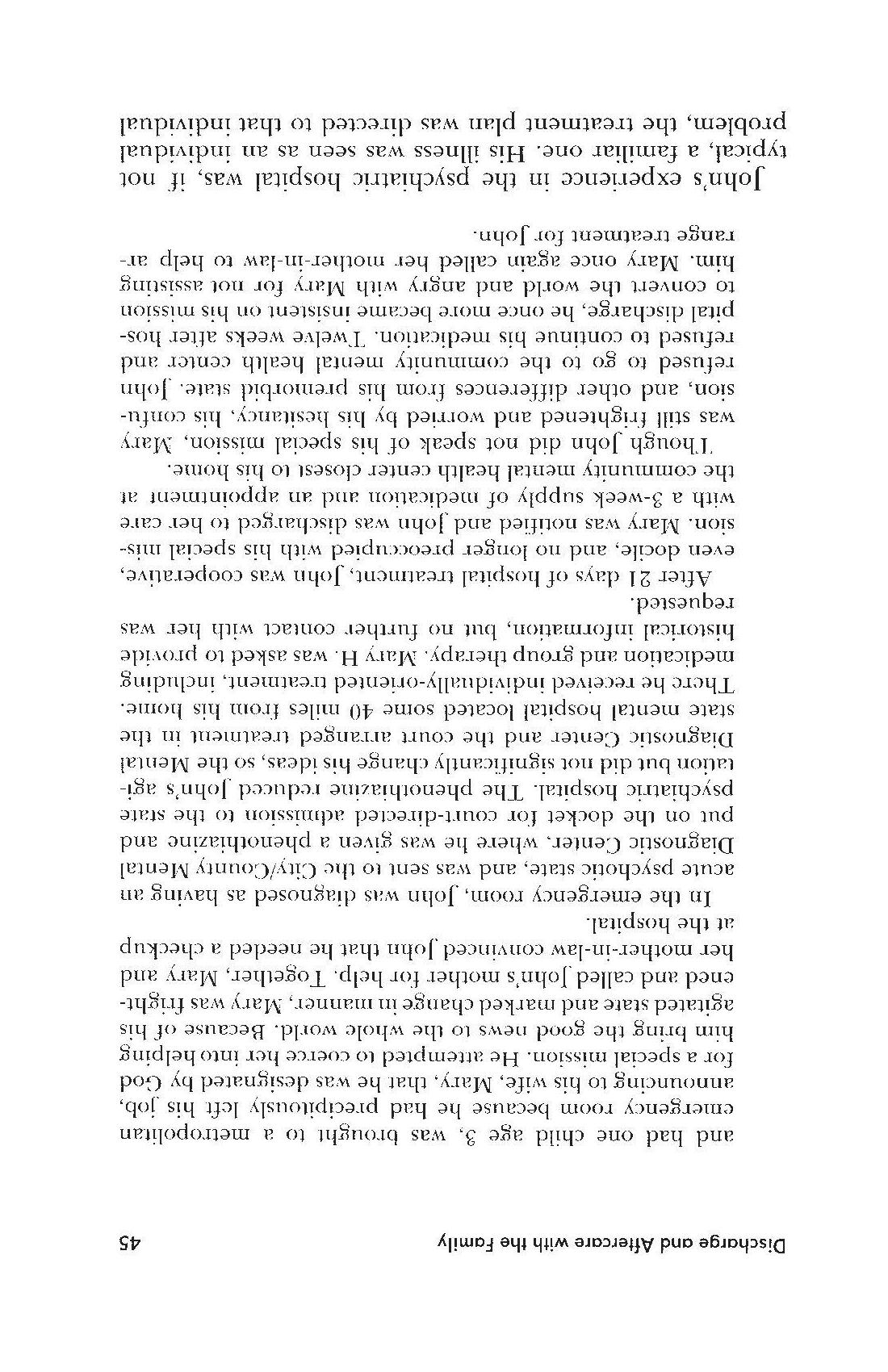
4 minute read
A Model for Inpatient Family Intervention
40 The Family, the Patient, and the Psychiatric Hospital
d
Advertisement
_ assical c(iange-orientcd family therapy, is almost always indicated. Even when the family is not available, interested or involved, the designated patient needs to be reconnected to another system.
4
DISCHARGE AND AFTERCARE WITH THE FAMILY
As we have described, going to a psychiatric hospital for the first time is traumatic, painful, and usually filled with negative implications to the patient, the family, and the larger community. :\To less so (but for different reasons) is the event of dischar�e from the hospilal. Patients are often caught up in a system they only dimly understand. They are "processed" and then sent out into the community with great uncertainty about how they can reorganize their lives. This chapter deals ·with the task of including the family in the planning and management of the hospitalized patient's discharge into the community. Involving the family in the patient's posthospital treatment requires little overall change in the health care delivery system, but rather utilizes existing psychiatric institutions without radically redefining illness, treatment, or the social roles of patients, families, and therapists. Our focus is on urgently needed ways to increase patient functioning and LherapeuLic efficacy, with emphasis on evaluations, comparisons and outcomes. The presentation is divided into two parts: I) working with the families of psychiatric inpatients who are not defined as chronic, and 2) working with the chronic psychiatric patient. This distinction is made and utilized because individuals, families, and institutions recognize the difference and respond quite differently to the two conditions. With a first and second psychotic break or inpatient experience, patients and their families
41
42 The Family, the Patient, and the Psychiatric Hospital
usuallv see the illness as an interruption or their life and expeci'. a return to normality. If third and subsequent hospital admissions occur, there is a slow but dramatic change in the definition of the patient from someone who has an illness to be treated and cured to someone who is qualitatively diff erent (and by inference inferior) to "normals." This definitional change requires significant alterations in treatment approaches. WHEN THE INPATIENT IS NOT DEFINED AS CHRONIC
Most psychiatric patients at first and second admission still have strong family and social ties (Rose, 1959). For such patients, legal, social, and economic forces in American society pressure for rapid discharge. The legal principle of "least restrictive care" dictates one major impetus. Many social groups, including those which purport to represent psychiatric patients' rights, advocate reducing the power of those in posit.ions of social control (i.e., professionals, administrators). Economically, legislators and third-party payers are increasingly aware that lengthy hospitalizations threaten their already tenuous cash flow.
These varied pressures, in conjunction with advances in treatment, e.g., medications, have resulted in a precipitous drop in hospital stay for psychiatric patients. Hospitalizations which were calculated in months in the 1960s are now reported in days, with enormous impact on our health care delivery system and on social concepts of mental illness and treatment. The psychiatric system, previously defined as a benevolent controller of social deviance, now has a less powerful image as only one of many social factors, while the mentally ill are understood as people needing help to establish and maintain a clear and socially reinforced role in the community.
Traditional psychiatry, with its emphasis on the individual, may not have been the best model for these dramatic changes

Discharge and Aftercare with the Family 43
in role definition. In the past, the family of the psychiatric patient was often seen primarily as a source of problems rather than as a potential ally. That view, with its implicit elitism, is out of step with current understanding. When patients are discharged without an adequate treatment plan t.hat includes the family, they reappear to be processed and discharged again in a never-ending spiral which unfortunately tends toward chronicity, hopelessness, and increasing isolation from the community. This is the so-called "revolving door" phenomenon (Talbott, 1971). Planning for discharge At first and second admission, most patients have family members concerned about their welfare. Since hospital time is being dramatically reduced, these family members must be involved in discharge planning. Whether in a public or a private setting, psychiatrists, psychologists, and social workers can interact with the family as partners in rehabilitation. Planning sessions that deal with the needs of the patients and the family alike are essential in promoting the patient's effective reentry into the broader sociely. As stated in Chapter 3, the hospit�l with a family orient�tion begins discharge planning on admission.
Data from a variety of sources indicate that any kind of severe emotional illness that requires hospitalization can best be treated by including the family in intervention efforts (Goldstein et al., 1978; Anderson et al., 1980; Falloon et al., 198 I). Evidence accumulates that families can be significantly more helpful following discharge when mental health professionals provide clear information, take the family's circumstances into account in aftercare planning, and attend to the interface between the identified patient and family members.
One stark, simple, and compelling reason for family involvement is the necessity for patients to continue on medication (May, 1975). Previously hospitalized patients who








